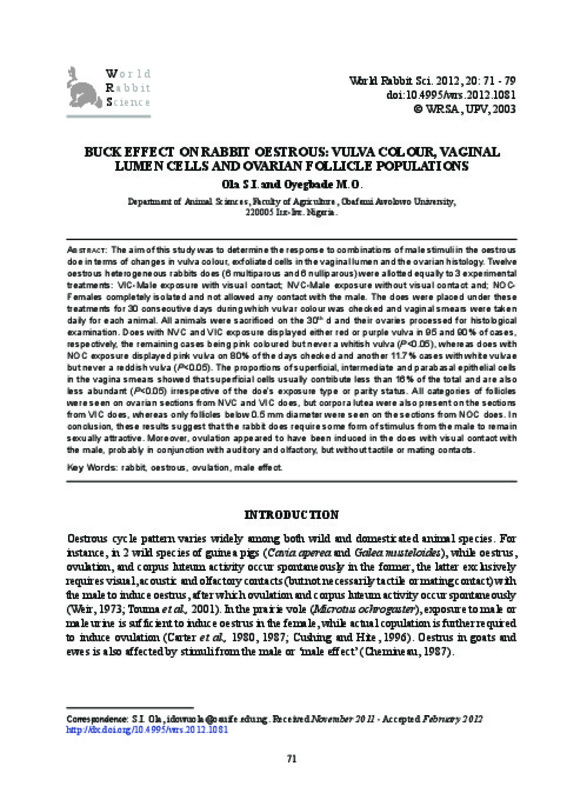JavaScript is disabled for your browser. Some features of this site may not work without it.
Buscar en RiuNet
Listar
Mi cuenta
Estadísticas
Ayuda RiuNet
Admin. UPV
Buck effect on rabbit oestrous: vulva colour, vaginal lumen cells and ovarian follicle populations
Mostrar el registro sencillo del ítem
Ficheros en el ítem
| dc.contributor.author | Ola, Idowu
|
es_ES |
| dc.contributor.author | Oyegbade, Moses
|
es_ES |
| dc.date.accessioned | 2012-07-19T07:03:55Z | |
| dc.date.issued | 2012-06-30 | |
| dc.identifier.issn | 1257-5011 | |
| dc.identifier.uri | http://hdl.handle.net/10251/16703 | |
| dc.description.abstract | [EN] The aim of this study was to determine the response to combinations of male stimuli in the oestrous doe in terms of changes in vulva colour, exfoliated cells in the vaginal lumen and the ovarian histology. Twelve oestrous heterogeneous rabbits does (6 multiparous and 6 nulliparous) were allotted equally to 3 experimental treatments: VIC ¿ Male exposure with visual contact; NVC - Male exposure without visual contact and; NOC - Females completely isolated and not allowed any contact with the male. The does were placed under these treatments for 30 consecutive days during which vulvar colour was checked and vaginal smears were taken daily for each animal. All animals were sacrificed on the thirtieth day and their ovaries processed for histological examination following H & E staining. Does with NVC and VIC exposure displayed either red or pink vulva in 95 and 90% of cases, respectively, the remaining cases being rose coloured but never a whitish vulva (P<0.05), whereas does with NOC exposure displayed rose vulva on 80% of the days checked and another 11.7% cases with white vulvae but never a reddish vulva (P<0.05). The proportions of superficial, intermediate and parabasal epithelial cells in the vagina smears showed that superficial cells usually contribute less than 16% of the total and are also less abundant (P<0.05) irrespective of the doe¿s exposure type or vulva colour, except in male-isolated does with purple vulva. All categories of follicles were seen on ovarian sections from NVC and VIC does, but corpora lutea were also present on the sections from VIC does, whereas only follicles below 0.5 mm diameter were seen on the sections from NOC does. In conclusion, these results suggest that the rabbit does require some form of stimulus from the male to remain sexually attractive. Moreover, ovulation appeared to have been induced in the does with visual contact with the male, probably in conjunction with auditory and olfactory, but without tactile or mating contacts. | es_ES |
| dc.language | Inglés | es_ES |
| dc.publisher | Editorial Universitat Politècnica de València | es_ES |
| dc.relation.ispartof | World Rabbit Science | |
| dc.rights | Reserva de todos los derechos | es_ES |
| dc.subject | Rabbit | es_ES |
| dc.subject | Oestrous | es_ES |
| dc.subject | Ovulation | es_ES |
| dc.subject | Male effect | es_ES |
| dc.title | Buck effect on rabbit oestrous: vulva colour, vaginal lumen cells and ovarian follicle populations | es_ES |
| dc.type | Artículo | es_ES |
| dc.date.updated | 2012-07-19T06:40:53Z | |
| dc.identifier.doi | 10.4995/wrs.2012.1081 | |
| dc.rights.accessRights | Abierto | es_ES |
| dc.description.bibliographicCitation | Ola, I.; Oyegbade, M. (2012). Buck effect on rabbit oestrous: vulva colour, vaginal lumen cells and ovarian follicle populations. World Rabbit Science. 20(2):71-79. https://doi.org/10.4995/wrs.2012.1081 | es_ES |
| dc.description.accrualMethod | SWORD | es_ES |
| dc.relation.publisherversion | https://doi.org/10.4995/wrs.2012.1081 | |
| dc.description.upvformatpinicio | 71 | |
| dc.description.upvformatpfin | 79 | |
| dc.description.volume | 20 | |
| dc.description.issue | 2 | |
| dc.identifier.eissn | 1989-8886 |








